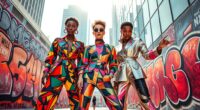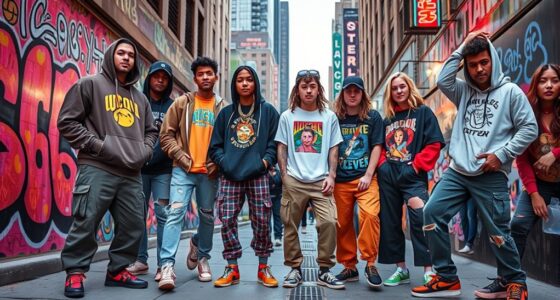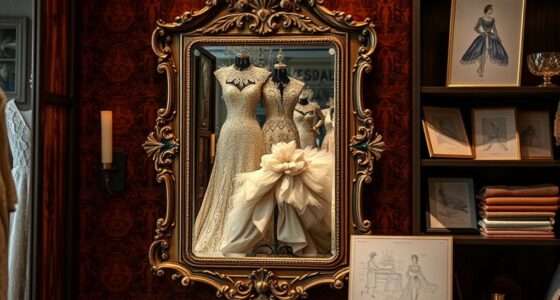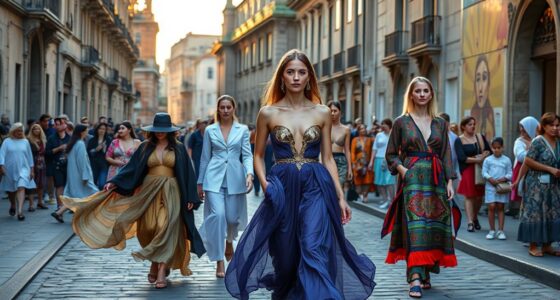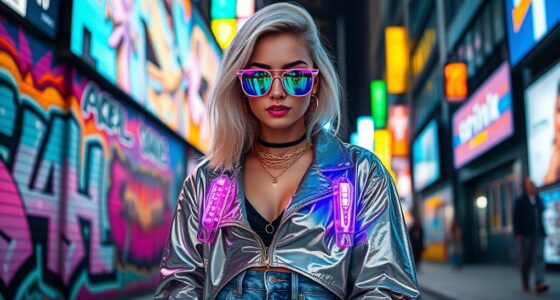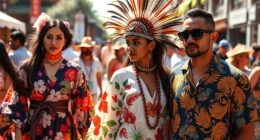Music and fashion have a deep, dynamic connection, with artists shaping trends through iconic styles on stage and off. From album covers to streetwear, their looks express cultural identities and often set mainstream trends. Red carpet moments and collaborations push new fashion ideas, while evolving styles reflect societal shifts. Technology and sustainability are also influencing future trends. To explore how this vibrant interplay continues to evolve, keep exploring this fascinating topic.
Key Takeaways
- Artists’ visual identities, including album covers and performances, shape fashion trends and influence cultural aesthetics.
- Musical genres historically inspire distinctive fashion styles reflecting societal values and cultural shifts.
- Red carpet and streetwear choices by artists set industry trends and inspire fan and mainstream fashion.
- Fashion helps craft musical personas, reinforcing artists’ cultural icons and their influence on industry standards.
- Technological advances like wearable tech and virtual reality are transforming live performance styles and industry innovation.
The Roots of Style: Music’s Fashion Foundations

Music has long been a powerful platform for expressing style, shaping trends that extend beyond sound to visual identity. You can see this influence in early jazz and blues artists, whose distinctive looks helped define the era’s vibe. As rock and roll emerged, musicians like Elvis Presley and The Beatles set new standards for fashion, blending rebelliousness with charisma. Hip-hop’s roots in the 1970s introduced bold streetwear, reflecting urban culture and identity. These styles weren’t just clothes—they became symbols of attitude and belonging. The evolution of music genres often coincided with new fashion statements, showing how artists used their appearance to communicate their message and connect with fans. Additionally, music’s fashion history demonstrates how trends are driven by cultural shifts and individual creativity, often influenced by the broader fashion industry and its ever-changing styles. The integration of musical performance and fashion continues to evolve, inspiring modern artists to push boundaries and redefine style standards. As technology and social media influence both music and fashion, artists now have even greater platforms to showcase their unique personal style and impact cultural conversations. Your style choices in music have long shaped cultural conversations and set the stage for future trends, with innovations like digital media further amplifying their reach.
Iconic Album Covers and Their Fashion Statements
Have you ever noticed how an album cover can instantly convey an artist’s style and attitude? It’s more than just artwork; it’s a bold fashion statement that defines a moment or a persona. Think of Nirvana’s “Nevermind” cover, with its underwater shot that captures grunge’s raw, rebellious spirit. Or Beyoncé’s “Lemonade,” where the visual symbolism and fashion choices highlight empowerment and resilience. These covers influence trends, inspiring fans and designers alike. They become iconic symbols, blending music with visual style in ways that leave a lasting impression. The right album cover can encapsulate an artist’s image, making a statement that resonates far beyond the music itself. It’s a powerful form of visual storytelling that cements their place in cultural history. Additionally, visual branding plays a crucial role in establishing a cohesive aesthetic that artists carry through their music videos and performances.
Artists as Style Icons: Red Carpet and Streetwear

You see artists setting trends both on the red carpet and in streetwear, shaping how fans and designers view style. Their glamorous looks and casual streetwear moments create iconic fashion statements that resonate worldwide. These style choices turn artists into true icons, inspiring countless fashion moments. Additionally, their influence often extends to seasonal fashion trends, encouraging fans and designers alike to explore new styles and adapt to changing tastes. As AI tools become more integrated into fashion design and marketing, artists’ styles can be more dynamically analyzed and promoted, further amplifying their influence on fashion innovation. The integration of latest technologies in fashion further enhances how artists’ styles are curated and showcased. This synergy between music and fashion demonstrates how artists serve as powerful style influencers, impacting industry standards and consumer preferences across the globe.
Red Carpet Glamour
When artists step onto the red carpet, they don’t just showcase their talent—they set fashion trends that influence millions. Every gown, tuxedo, or statement accessory becomes a blueprint for fans and fashion lovers worldwide. Your favorite stars understand that their outfits are more than just clothing; they’re powerful tools to express identity, challenge norms, or pay homage to cultural moments. Designers passionately dress celebrities to make bold statements, knowing the world will scrutinize every detail. Whether it’s an elegant gown or a daring tuxedo, these looks often spark new trends in mainstream fashion. As a viewer, you’re inspired by these glamorous displays, often imitating styles or dreaming of the next show-stopping appearance. Red carpet fashion is a dance of creativity, influence, and cultural storytelling. Additionally, celebrities often incorporate low light office plants into their styling or set designs, subtly blending everyday elements with high fashion to create unique visual narratives. This fusion of fashion and environment echoes the growing importance of digital literacy in contemporary culture, where visuals and symbolism communicate powerful messages, and the use of interior design elements can elevate the overall aesthetic.
Streetwear Influence
Streetwear has become a dominant force in shaping artists’ public images, blurring the lines between high fashion and everyday style. When you see artists rocking hoodies, sneakers, and oversized tees, you’re witnessing how streetwear elevates casual pieces into statements of cultural relevance. Many musicians now serve as style icons by blending luxury brands with street-inspired looks, making these trends mainstream. Their influence encourages fans to adopt similar styles, creating a cycle where streetwear becomes both a fashion statement and a symbol of authenticity. You’ll notice that artists often wear limited-edition sneakers or customized streetwear, reinforcing their connection to urban culture. This fusion of music and street style not only defines current fashion but also empowers fans to embrace individuality through comfort and creativity. Additionally, the integration of fashion elements from the music industry helps solidify artists’ roles as trendsetters and cultural icons. The rise of urban fashion as a mainstream aesthetic demonstrates how deeply these styles are embedded in contemporary culture.
Iconic Style Moments
Have you ever noticed how certain artists turn red carpet appearances into unforgettable fashion moments? They effortlessly blend bold choices with iconic style, making headlines and setting trends. Think of Beyoncé’s stunning Grammy looks or Lady Gaga’s daring Met Gala outfits—each one becomes a symbol of their influence. These moments not only showcase their personalities but also inspire millions worldwide. To picture it:
| Artist | Style Moment |
|---|---|
| Beyoncé | Silver, figure-hugging gown with statement accessories |
| Lady Gaga | Meat dress at the MTV VMAs |
| Rihanna | Yellow canary gown at the CFDA Fashion Awards |
| Kanye West | All-black, oversized hoodie at Paris Fashion Week |
These style moments define eras and cement their status as style icons.
The Role of Fashion in Crafting Musical Personas
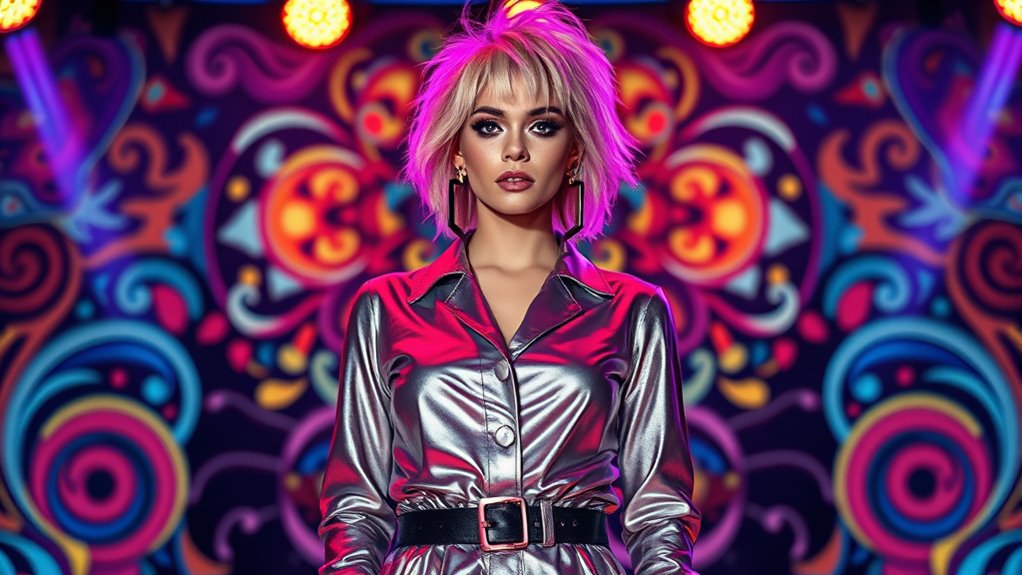
Fashion plays a pivotal role in shaping a musical artist’s identity, allowing performers to visually communicate their personality and artistic vision. When you choose a specific style, you send a clear message about who you are and what your music stands for. This visual presentation helps fans connect with your image, making your persona memorable. Whether you favor edgy leather, bohemian flow, or sleek sophistication, your wardrobe becomes an extension of your music’s mood. Consistent fashion choices reinforce your brand, making it easier for audiences to recognize and relate to you. Additionally, incorporating visual elements like color schemes and styling can further enhance how your image aligns with your musical genre and audience expectations. It is also important to understand how musical genre influences fashion and shapes the overall aesthetic. Moreover, staying current with fashion trends in the industry can help you maintain a fresh and relevant image. Recognizing the impact of market trends and audience preferences can further refine your style and appeal. For example, some artists leverage social media and influencer collaborations to keep their fashion sense aligned with current industry standards. Ultimately, fashion isn’t just about looking good; it’s a powerful tool to craft a distinct musical persona that resonates long after the song ends.
Collaborations Between Musicians and Fashion Brands

Musicians and fashion brands are increasingly teaming up to create powerful collaborations that amplify both their images and reach. When you see a famous artist partnering with a designer, it’s more than just marketing—it’s a statement. These collaborations often produce limited-edition collections that fans *enthusiastically* seek out, blending music’s energy with fashion’s creativity. The musician’s personal style influences the designs, making the pieces authentic and highly desirable. Brands benefit from the musician’s influence, reaching new audiences and adding credibility. For you, these collaborations mean access to exclusive merchandise that embodies both music culture and high fashion. Whether it’s a rapper’s sneaker line or a pop star’s clothing capsule, these partnerships bridge the gap between music and style, creating buzz and setting trends you want to follow. Such partnerships are also shaping the vibrant world of Bollywood fashion, where music and style collide to create unique cultural statements. Additionally, integrating home decor elements into merchandise, like themed wall art or decorative accessories, is becoming a new trend that reflects personal style beyond clothing. This fusion of music-inspired design can also extend to specialty teas, where unique branding and thematic elements are incorporated into packaging, appealing to fans’ diverse interests. Furthermore, art theory plays a role in how these collaborations are conceptualized, ensuring that each piece resonates with cultural and aesthetic significance. It’s fascinating to see how copyright and branding strategies are employed to protect and promote these collaborative creations effectively.
The Evolution of Music Fashion Through the Decades
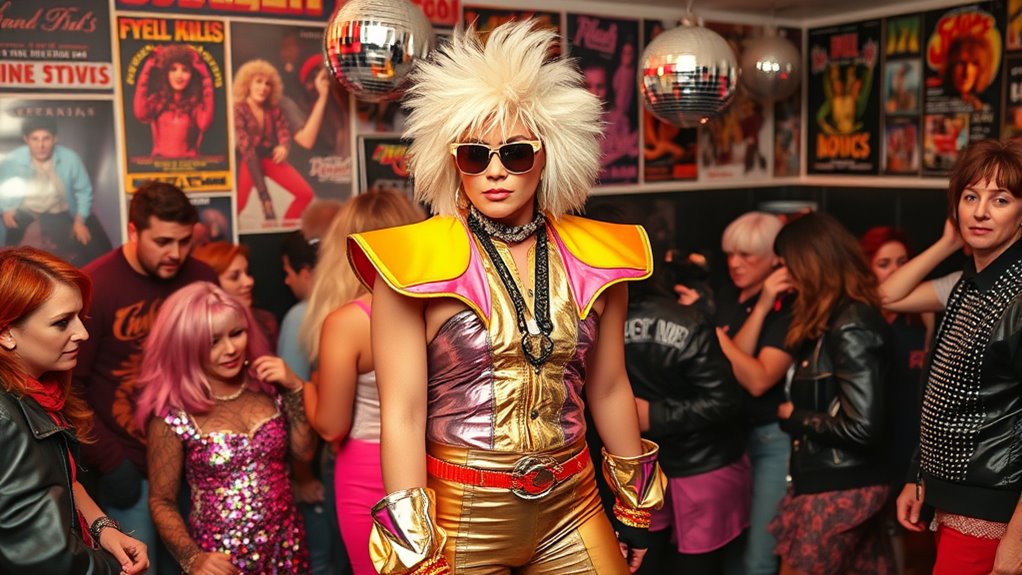
Music-inspired styles have constantly evolved, reflecting broader cultural shifts and the personalities of iconic artists. In the 1950s, you might have embraced rockabilly or leather jackets inspired by Elvis Presley, signaling rebellion and youthful energy. The 1960s brought the counterculture movement, so tie-dye and bell-bottoms became your statement of peace and freedom. Moving into the 70s, disco and glam rock pushed bold colors, platform shoes, and glitter, making every outfit a stage. The 80s saw you rocking exaggerated shoulders, neon colors, and punk influences, expressing individuality and rebellion. The 90s introduced grunge and hip-hop styles, favoring flannel shirts, baggy jeans, and athletic wear. Each decade’s fashion mirrored societal values, musical genres, and the personalities of artists shaping the cultural landscape. Additionally, the integration of music and fashion has also been influenced by changing consumer preferences, which continuously shape the trends embraced by audiences worldwide. Moreover, the influence of cybersecurity vulnerabilities during major events has occasionally led to shifts in industry practices and public perception. The emergence of monster-inspired motifs and gothic aesthetics in certain eras further exemplifies the close relationship between music genres and visual styles.
Future Trends: How Technology and Sustainability Shape Music Style
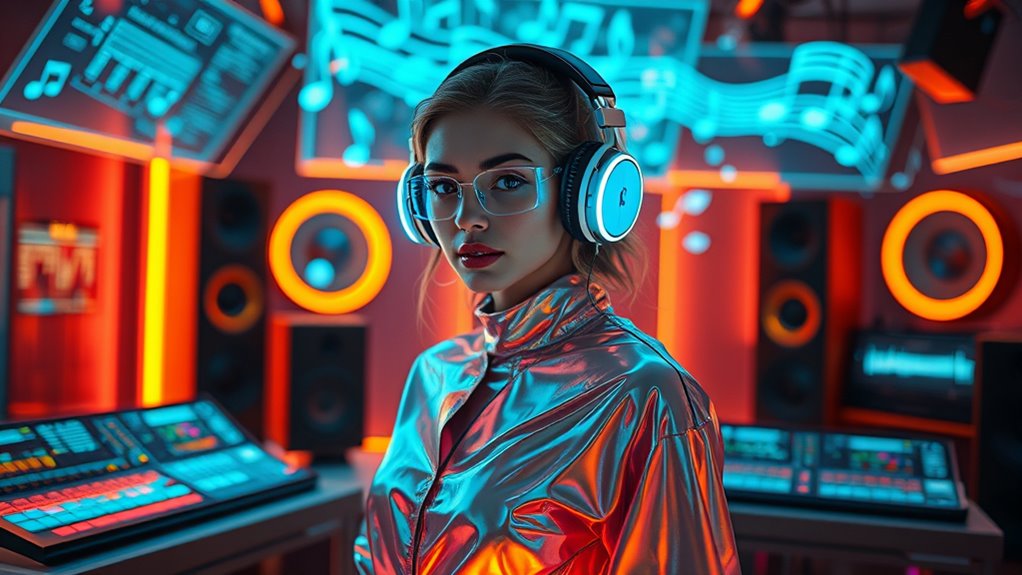
As technology advances and environmental concerns grow more urgent, the way you express your style in the music scene is quickly evolving. Virtual reality and augmented reality are transforming live performances, allowing you to showcase innovative, interactive looks that blend digital and physical worlds. Sustainable fashion is also gaining momentum, encouraging you to choose eco-friendly fabrics and upcycled pieces that make a statement without harming the planet. Wearable tech, like smart fabrics and LED-enabled clothing, will become more common, letting you personalize your style in real-time. These trends empower you to stand out while aligning with values of sustainability and innovation. In the future, your music style will not only reflect your personality but also demonstrate your commitment to a more sustainable and technologically advanced world.
Frequently Asked Questions
How Do Regional Cultures Influence Music-Inspired Fashion Trends Globally?
Regional cultures shape music-inspired fashion trends worldwide by infusing local styles, symbols, and traditions into global scenes. You notice how traditional patterns, colors, and clothing influence artists’ looks, creating unique blends of cultural identity and modern fashion. This cultural exchange encourages diversity and authenticity in music fashion, inspiring fans and designers alike. As regional influences spread through social media and collaborations, you see a richer, more inclusive global fashion landscape emerging from local roots.
What Role Does Gender Fluidity Play in Contemporary Music Fashion?
Imagine if David Bowie’s Ziggy Stardust era met today’s stage—gender fluidity in music fashion is breaking barriers, letting you express yourself beyond traditional roles. You can embrace bold, androgynous looks that challenge norms, inspiring confidence and authenticity. This movement encourages you to experiment with styles that reflect your identity, making fashion a powerful statement of personal freedom. Gender fluidity now shapes a more inclusive, creative, and expressive music scene for everyone.
How Do Underground Music Scenes Impact Mainstream Fashion Styles?
You notice how underground music scenes influence mainstream fashion by pushing bold, experimental styles that often seem edgy and unconventional. These scenes foster creativity and originality, inspiring mainstream brands to adopt alternative looks. As you follow these trends, you see how underground artists challenge norms, making fashion more diverse and inclusive. Your style can reflect this blend of underground authenticity and mainstream appeal, showing your support for innovation in both music and fashion.
What’S the Influence of Music Festivals on Fashion Innovation?
Music festivals act like a melting pot, sparking fashion innovation you can’t ignore. As you attend these events, you’re inspired by bold styles and creative expressions that push boundaries. You see trends like neon, eclectic accessories, and statement pieces emerge, influencing mainstream fashion. Festivals become a runway of raw, unfiltered style, encouraging you to experiment and redefine your look, turning fleeting moments into lasting fashion statements.
How Do Brand Collaborations Affect Musicians’ Personal Style Identity?
Brand collaborations can profoundly shape your personal style identity by blending their distinctive aesthetics with your musical image. When you work with a brand, you gain access to new styles and trends, which you can incorporate into your look. This partnership allows you to experiment confidently, expressing your personality while aligning with popular culture. Ultimately, collaborations help you refine and evolve your style, making it more authentic and memorable to your fans.
Conclusion
As you navigate the vibrant tapestry of music and fashion, remember they’re dance partners in a never-ending waltz of self-expression. Every album cover, every red carpet stride, paints a vivid stroke on the canvas of culture. With technology and sustainability leading the charge, this fusion will only grow more dynamic, like a river carving new paths. Embrace the style symphony—where your voice and vision compose the future’s most inspiring melody.

